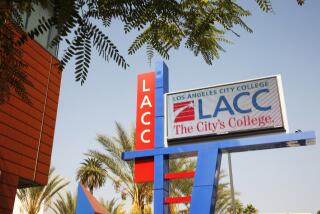Companies and Colleges <i> Should </i> Team Up
- Share via
In the early 1970s, Monsanto Co . and Harvard University embarked on a 12-year, $10-million partnership that was expected to yield a harvest of scientific discovery and financial reward. But although the project came up with some interesting science, it could claim little in the way of significant commercial value.
Undeterred, Monsanto tried again in the 1980s, this time with Washington University, which is near the company’s St. Louis headquarters. The $62-million project included shared decision making and the movement of scientists between the two institutions. After eight years, with adjustments on both sides, the university and Monsanto say the partnership has worked well; by 1989, more than 40 patent applications had been filed.
From this experience, in addition to some interesting science, Monsanto has learned that partnerships between corporations and universities can be tricky endeavors--and that they can also be highly successful.
In the 1990s, that second perspective is an important one for corporations and universities to gain, for the two need each other as never before.
For centuries, business and academe have believed that they have little in common. After all, the business of business is to make money, while the business of universities is to seek knowledge. Traditionally, academic institutions have resisted anything that might corrupt the purity of their pursuits. Corporate involvement, it has long been feared, might prostitute science to profit.
Business, on the other hand, has often failed to understand the exploratory and incremental nature of scientific research and has been frustrated by what it sees as the high cost and unfocused activity of academic science.
In recent years, those mutual misunderstandings have become costly. Not so long ago, the 1990s were being touted as the decade of biotechnology, when the scientific discoveries of the previous two decades would be transformed into profitable products for U.S. corporations. So far, few of those dreams have been realized. The United States is now fifth in the number of patents obtained. In recent years, Japan has introduced three times the number of biomedical products that we have.
Our inability to gain pre-eminence in the biomedical industry can be traced, at least in part, to the failure of our companies and universities to form strong and productive alliances.
Misunderstandings between the two have not only been costly for industry, they have adversely affected the academic world. Federal money, which has funded so many of the major scientific breakthroughs at universities in recent years, can no longer sustain the momentum it helped to create. The costs of training scientists, acquiring sophisticated instruments and maintaining first-rate scientific establishments have grown beyond the means of even the richest universities, and seed money to develop promising scientific ideas is almost impossible to find.
In short, business and academe can no longer afford to ignore each other. Mistrust must give way to mutual understanding. As is often the case, however, finding the right chemistry will take time.
For one thing, both sides need to understand that they bring different strengths to research efforts. Pharmaceutical development, for instance, takes years to complete. University laboratories can contribute the most in the early stages, by providing ideas, tools and the initial leads that flow into the research pipeline. Industry, on the other hand, can provide greater expertise later on, when it comes to defining and developing products and securing regulatory approval.
The risks, costs and rewards associated with various stages of development differ tremendously. It is important, therefore, that each partner define its goals and objectives, the scope of collaboration, terms of ownership and provisions for cashing out. Most important, both players need to have realistic expectations of the returns appropriate to their level of participation.
In the end, realistic expectations may be the key to success in nearly all facets of corporate and academic partnerships.
Any company expecting a quick payoff will be disappointed; it must be willing to count the smallest deposit in the bank of knowledge as part of the total return. A company should define its “basic science” objectives, be willing to learn from the academic team, hold reasonably frequent integrated review meetings and, where possible, exchange scientists.
In a successful partnership, a company invests more than money in the university lab; it commits time and staff.
Universities, too, need realistic expectations. Those that expect high up-front fees and large royalties need to understand that only products well along in the development process will produce significant licensing revenue. Early-stage products and processes bear too high an investment risk to justify high licensing prices.
Academic scientists need to recognize that business partnerships require different operating procedures from academic ones. At the very least, most entrepreneurial efforts begin with a new budget and staff. Researchers are expected to focus--for sustained periods--on their projects. And there is the expectation that research centers themselves must invest in the products they help develop, thereby acknowledging that large rewards often require substantial risk.
As Monsanto has discovered during the past two decades, such partnerships are not without their problems. But they can, when structured properly, prove beneficial for both sides.
More to Read
Inside the business of entertainment
The Wide Shot brings you news, analysis and insights on everything from streaming wars to production — and what it all means for the future.
You may occasionally receive promotional content from the Los Angeles Times.










